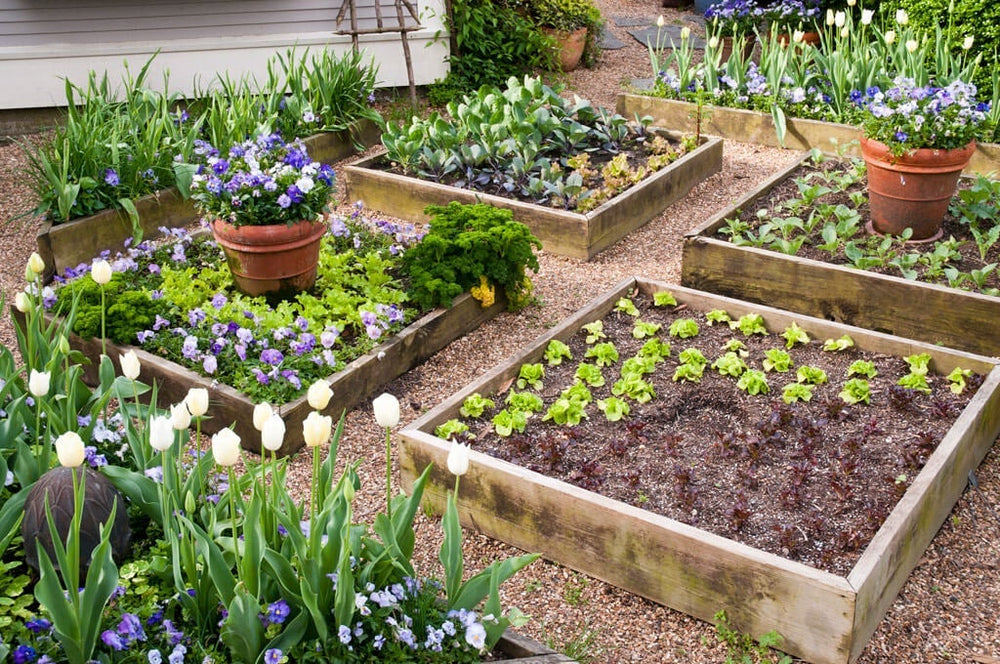What is a raised bed garden? It's an enclosed planting area on top of the ground that offers one huge benefit: You never have to deal with poor soil, because you control what goes in the bed. So if even your native soil is soggy, heavy clay, pure beach sand, rocky, or barren of nutrients, you can still grow a beautiful, productive garden if you do it in a raised bed. What's more, because raised beds don't require planting in rows, you'll actually be able to fit more plants in than you would in a traditional garden of the same size — so you'll eventually end up with a bigger harvest. Need a little extra garden space? You guessed it: You can get it easily with a raised bed.
More Reasons
Another reason to build a raised garden bed is to give your garden definition by creating neat edges. Each raised bed can become a feature in your garden design, especially if you are the type of gardener who enjoys keeping your plants neatly groomed. Vegetables and herbs can be very pretty!
The sides of a raised bed garden can be anywhere from 6 inches deep to 20 inches or more. Shallow beds work just fine for shallow-rooted vegetables like lettuce and spinach, but you'll need deeper beds for plants with sprawling root systems, like tomatoes and peppers. Beds built to accommodate people who are unable to bend or in a wheelchair should be raised to about 30 inches. (You can build or purchased elevated, table-style raised beds if you prefer.)
Some raised garden beds have bottoms, while others don't. If there is a bottom, it might be solid or made of hardware cloth designed to keep pesky rodents from tunneling up into your garden from below. Raised bed bottoms should always have plenty of drainage holes.
To create a raised bed garden, find a level, sunny spot near a water source. It could be on your lawn, on an unused portion of your driveway, even on a deck or patio if you're planning to buy or build a raised bed with a bottom. If the location is on grass, cut the grass short, then lay down several layers of newspaper or cardboard to keep weeds from growing up into the bed. If your only choice is to garden on a slope, position the bed so it runs across the slope, not downhill.
The sides of your raised bed can be made from an endless choice of materials, such as lumber, concrete blocks, logs, stone, straw bales, or whatever else strikes your fancy. Make each bed as long as you'd like, but limit the width to 3 or 4 feet at the most. You need to be able to easily reach from the edge to the center from each side without having to step onto the growing area. (Need more guidance? Check out our 3 Easy Ways to Build a Raised Bed article.)
Another soil option (and one that involves a bit more work on your part) is to combine compost with native soil. Some municipalities will deliver composted leaves for a reasonable charge. If possible, include 1 part native soil to 3 parts compost. Be careful, though: You'll want to avoid native soil if you live in an area known for root-knot nematodes, verticillium wilt, or fusarium wilt, all which are soil-borne enemies of tomatoes and other vegetables. Check with your regional extension agent if you are not sure if these are a concern in your area. Using native soil could introduce these problems to your bed.Fill the bed with a soil mix that is rich and porous enough to let air get to the roots, and holds moisture while draining well. Miracle-Gro® Performance Organics® Raised Bed Mix made specifically for raised beds, will provide just the right environment for your plants' roots. Hands down, it's the easiest way to fill up your beds.
Unlike the layout of a traditional in-ground garden, which can change from year to year, your raised bed garden will keep the same layout season after season. Your paths between the beds will become permanent. Minimize maintenance by using 3 to 4 sheets of newspaper covered by mulch to prevent weeds in the pathways. You can also put grass clippings, chopped leaves, and other compostable materials on the path. At the end of the season, add the decomposed material to the beds to improve the soil.
Throughout the season, make sure the plants in your raised bed get all of the nutrition they need to flourish by feeding them with a continuous-release plant food like Miracle-Gro® Performance Organics® Raised Bed Plant Nutrition Granules This is especially important if you're planting your vegetables a little more closely than you would in the ground, since you don't want them to compete for nutrients.
Enjoy your raised beds. They are a great way to increase the productivity of a garden and get lots of food from a small space.







 Herbs
Herbs
 Vegetables
Vegetables
 Fruit
Fruit
 Flowers
Flowers
 Succulents
Succulents


